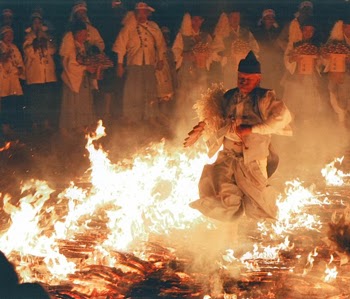< 1. God of India >
We look at the
medical art of ancient India from this time.
Atharvaveda
This was established in
about 1000 years B.C., was a sacred book for the private sectors, and had a
relationship with medical treatment most.
This excluded disaster
by magic, prayed for beatification, and aimed for medical treatment, love,
victory, good luck, and expiation.
The object of disease
treatment was diarrhea, heart disease, skin disease, tumor, fracture,
intestinal worm, and poison of snake, and eye disease etc.
And it also included
energy reinforcement and long life.
For example, the
treatments were that a patient caught the hand of a magician, and made an
incantation.
The treatment of fever
was to transmit it to a woman of Sudra (slave), and the treatment of headache
and coughs was to transmit it to the trees of hill and forest
For constipation, the
patient was made to drink the soil of a rat hole along with singing a devotional
song.
今回から古代インドの治療を見ていきます。
これは前1千年頃に成立し、最も治療に関わりを持つ民間向けの聖典でした。
これは呪術により災厄を祓い、招福を祈願し、治療、恋愛、戦勝、開運、贖罪などを目的とした。
病気治療の対象は下痢、心臓病、皮膚病、腫瘍、骨折、回虫、蛇の毒、眼病などがあり、精力増強、長生きも含まれていた。
例えば、治療は患者が呪術師の手を掴み呪文を唱え、熱病はシュードラ(slave)の女に、頭痛と咳は丘と森の木々に感染させることであった。
便秘に対しては、賛歌の詠唱と共に、患者は鼠穴の土などを呑まされた。
< 2. The spice of
curry was based on Ayurveda >
Birth of Ayurveda
In the early stages,
Brahmin (flamen) doubled also as doctor, and mainly treated sickness by means
of using magic.
Before long, the
experience and the knowledge about sickness or medicinal herb had been
accumulated, and two medical schools that specialized in the internal medicine and
the surgery treatment appeared in the 6th century.
These had been
integrated into a system of Ayurveda (knowledge of the life) during several
centuries A.D., and moreover it adopted yoga and developed.
初期は、バラモン(祭官)が医者を兼ねて、主に呪法を用いて治療を行っていた。
やがて病気や薬草に関する経験と知識が蓄積され、前6世紀には、内科治療を専門とする学派と外科治療も取り入れた学派が出現していた。
これらが紀元後数世紀の間にアーユル・ベーダ(生命の学問)の体系に集成され、さらにヨーガを取り入れ発展していった。
< 3. 16 major
nations: The first city-states were born.
>
When it came at the 7th century B.C.,
rice cropping and trade became popular in Ganges basin, and many city-states
were born.
This pushed the society toward the birth
of freethinker, Sakyamuni, and medical school.
前7世紀になると、ガンジス川流域で稲作と交易が盛んになり幾多の都市国家が誕生した。
このことが自由思想家、釈迦、医学学派の誕生へと向かわせた。
Change of the medical treatment
According to typical
etiology of Ayurveda, the sickness was that the equilibrium among yellow bile,
viscous liquid, winds, and blood collapsed.
In order to regain this
equilibrium, patients must eat and drink sweet, acid, bitter, salt, and
astringent depending on his condition.
For example, it is said
that the acid is effective in the increase of digestion or mental function.
There are many medicines
to treat, and they consist of minerals, animals, and 1000 or more kinds of
medical herbs, and the purpose and the usage are classified.
Some medicines were the Egypt origin and
the curative medicines of skin disease reached 100 kinds.
There were many
medicines with clear effect and they used opium, ginger, cinnamon, wolfsbane,
castor oil, alum, mercury, etc.
The mainstream of
medical treatment was emetic method, enemas, nasal drops method, and phlebotomy
method (bloods are drained).
アーユル・ベーダの代表的な病因論では、胆汁、粘液、風、(血液)の平衡が崩れた状態が病気と考えられている。
この平衡を取り戻すには甘・酸・苦・辛・塩・渋の六味を症状に応じて飲食させる。
例えば酸は消化力増大・精神機能増進に効果があるとされている。
扱う薬物は多く、鉱物、動物、一千種類以上の薬草があり、目的と用法が分類されている。
薬物にはエジプト由来もあり、皮膚病の治療薬は百種類に達した。
効能が明確な薬物は多く、アヘン、ショウガ、シナモン、トリカブト、ヒマシ油、明礬、水銀などを用いた。
治療法は吐法、浣腸法、点鼻法、瀉血法(血液を一部抜く)が中心である。
< 4. a relief
engraving of a tooth extraction >
The name of diseases of
internal medicine exceeds 300 kinds, and hiccups, the
illness of head, and insanity are also included.
There were surgical
operations of anal fistula, fracture, tooth extraction, renal calculus,
cataract, and nose job, etc.
The doctor did
auscultation of patient, observed the state of his skin or his tongue, and
judged diabetes with tasting his urine.
In this way, the
conversion to medical art of empirical science from it of only past magic
happened.
内科の病名は300種類を越え、シャックリ、頭の病、狂気も含まれている。
外科手術には痔瘻、骨折、抜歯、結石、白内障、鼻の整形などであった。
医者は聴診、皮膚や舌の状態を観察し、患者の尿を味見し糖尿病を判断した。
こうして過去の呪術一辺倒から経験科学の医術への転換が起こった。























